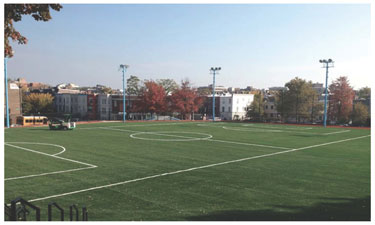 On November 7, 2013, Marie Reed Elementary School, located in the Adams Morgan community in the heart of Washington, D.C., celebrated a newly renovated soccer field and amphitheater. In reality, these renovations represent much more than new facilities — the community has received a long-awaited beautiful location that elevates the quality of life in the neighborhood.
On November 7, 2013, Marie Reed Elementary School, located in the Adams Morgan community in the heart of Washington, D.C., celebrated a newly renovated soccer field and amphitheater. In reality, these renovations represent much more than new facilities — the community has received a long-awaited beautiful location that elevates the quality of life in the neighborhood.
It is useful to contextualize this project within the history of the Adams Morgan neighborhood, long considered one of the most diverse communities in Washington, D.C. Adams Morgan derives its name from two formerly segregated elementary schools in the early 1950s: Thomas P. Morgan Elementary School (for African-American students) and John Quincy Adams Elementary School (for white students). The schools were desegregated in 1955, and a new elementary school and community hub — Marie H. Reed Elementary School — was constructed in the late 1960s. This marked the beginning of embracing diversity in Adams Morgan. “Marie Reed Elementary School is [considered] the best representation of ethnic and socioeconomic diversity in Adams Morgan,” says William Simpson, current commissioner of the local Advisory Neighborhood Commission.
However, degrading site conditions in the past few years caused this intended community hub to lose its desired use 50 years after its inception. The school field had become a dust bowl — drainage issues caused it to flood during rains, killing the grass and making the surface dry, uneven and unsafe for children to play on. The original amphitheater was made from railroad ties that had become exposed and rusted. The lack of intended use and dangerous site conditions encouraged illegal activities such as drinking, drug use and crime at Marie Reed’s field and amphitheater, which became more dilapidated over time.
In light of its historic character and unique needs, the Marie Reed Elementary School was selected by the United Arab Emirates (UAE) and Manchester City Football Club to receive a gift of a top-of-the-line artificial turf soccer field and a three-year coaching initiative as part of their “City Soccer in the Community” program. “This was a ‘home field’ for our partners in the program, the United Arab Emirates Embassy in D.C., and we could not have picked a better location than Marie Reed or better partners than the D.C. Schools and D.C. Parks District…. It’s amazing what can be achieved when folks work together for the good of the community. We are proud to be friends and partners and look forward to years of great soccer ahead,” Gary Hopkins, director of City Soccer in the Community, says.
It was also decided to include the renovation of the amphitheater and other areas surrounding the soccer field, for which the Department of General Services (DGS) managed the design and construction. This marked the start of the Marie Reed renovations project in early 2013. Once the scope of the project was finalized, there were many challenges to tackle in a short span of time. In addition to budget, schedule, permits, site access and issues related to staging, the project team devoted significant attention to the level of coordination and management required to accommodate the project’s many stakeholders. Successful execution and timely project delivery was possible only through extensive collaborative efforts by local and international partnerships, including the UAE Embassy in Washington, D.C., Manchester City Football Club, DGS, D.C. Department of Parks and Recreation, D.C. Public Schools and the Adams Morgan community.
“This is an exciting project for the Department of General Services, as it presented us with an opportunity to participate in an international partnership to elevate the quality of life for children who attend Marie Reed, along with families and residents in the Adams Morgan community,” says Brian J. Hanlon, DGS director. “This gift will truly make this site a place for children and their families to enjoy for years to come.”
Some of the improvements to the site included replacing the amphitheater seating with new precast segmented masonry blocks, artificial turf, permeable seating areas, and new and safer-access stairs. The field received a new artificial turf walking track, ornamental fencing and new pavers for the patio. A professional arborist also was engaged to protect the existing trees.
“In a very short timeframe, the team dealt with many project challenges, listened to the community’s concerns [related to the site] and worked hard to accommodate them, for which the community is very grateful…. The community was heard,” Simpson says. “From idea to opening was less than 12 months. That’s incredibly fast,” Marie Reed Principal Eugene Pinkard adds.
The children of Marie Reed Elementary School already are holding their after-school programs on this field, while Adams Morgan has begun using the new space with equal enthusiasm, planning activities such as movie nights and tree-planting initiatives. “This will be a game changer for our students and our school community,” Pinkard continues. “The soccer field will transform our curriculum and make a valuable space into a world-class facility.”
Regardless of socioeconomic background or ethnicity, every Marie Reed child and community member has equal access to the new facility and children’s soccer coaching programs. Renovating or modernizing facilities such as those at Marie Reed not only proves to be a resource for children and the community, but also acts as a catalyst in reducing a community’s socioeconomic discrepancies.
Shilpa Khatri, LEED, AP, PMP, is a Project Manager for Brailsford & Dunlavey.

